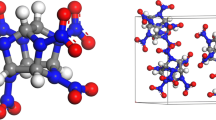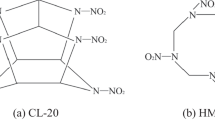Abstract
3-nitro-1,2,4-triazol-5-one (NTO)–based polymer-bonded explosives (PBXs) have been widely used in insensitive munitions, but the main properties of NTO-based PBXs such as compatibility, safety performance, and mechanical properties are rarely reported. In this work, molecular dynamics simulation was carried out to study interface interactions of NTO-based PBXs, in which hydroxy-terminated polybutadiene (HTPB), ethylene–vinyl acetate copolymer (EVA), glycidyl azide polymer (GAP), poly-3-nitratomethyl-3-methyl oxetane (Poly-NIMMO), and ester urethane (Estane5703) are selected as binders. The binding energy analysis indicates that the order of compatibility is NTO/GAP > NTO/Estane5703 > NTO/HTPB > NTO/Poly-NIMMO > NTO/EVA. Radial distribution function analysis results show that the interface interaction is mainly the hydrogen bond between H atoms of NTO and O atoms of Estane5703, HTPB, EVA, and Poly-NIMMO or N atoms of GAP. The values of cohesive energy density verify that the safety is NTO/GAP > NTO/Poly-NIMMO > NTO/HTPB > NTO/EVA > NTO/Estane5703. Mechanical properties results show that GAP and EVA would improve the plasticity of the systems effectively. Furthermore, it can be found that the most favorable interactions occur between the NTO (1 0 0) crystal face and binders.









Similar content being viewed by others
Data Availability
The datasets generated during and/or analyzed during the current study are available from the corresponding author on reasonable request.
References
Badgujar DM, Talawar MB, Asthana SN, Mahulikar PP (2008) Advances in science and technology of modern energetic materials: an overview. J Hazard Mater 151(2–3):289–305. https://doi.org/10.1016/j.jhazmat.2007.10.039
Baytos JF (1980) LASL explosive property data. University of California Press
Mathieu J, Stucki H (2004) Military high explosives. CHIMIA 58(6):383–389. https://doi.org/10.2533/000942904777677669
Dong HS, Zhou FF (1984) High energy explosives and correlative physical properties. Science Press, Beijing
Li MM, Shen RQ, Li FS (2011) Molecular dynamics simulation of binding energies, mechanical properties and energetic performance of the RDX/BAMO propellant. Acta Phys-Chim Sin 27(6):1379–1385. https://doi.org/10.3866/PKU.WHXB20110601
Song XY, Xing XL, Zhao SX, Ju XH (2019) Molecular dynamics simulation on TKX-50/fluoropolymer. Modell Simul Mater Sci Eng 28(1):015004. https://doi.org/10.1088/1361-651X/ab5497
Lan GC, Jin SH, Wang DX, Li J, Lu ZY, Jing BC, Li LJ (2018) Investigation of the effect of the CAB/A3 system on HNIW-based PBXs using molecular dynamics. J Mol Model 24(7):1–9. https://doi.org/10.1007/s00894-018-3670-3
Li SS, Xiao JJ (2021) Molecular dynamics simulations for effects of fluoropolymer binder content in CL-20/TNT based polymer-bonded explosives. Molecules 26(16):4876. https://doi.org/10.3390/molecules26164876
Wang XJ, Xiao JJ (2017) Molecular dynamics simulation studies of the ε-CL-20/HMX co-crystal-based PBXs with HTPB. Struct Chem 28(6):1645–1651. https://doi.org/10.1007/s11224-017-0930-2
Xiao HM, Li JS, Dong HS (2001) A quantum-chemical study of PBX: intermolecular interactions of TATB with CH2F2 and with linear fluorine-containing polymers. J Phys Org Chem 14(9):644–649. https://doi.org/10.1002/poc.403.abs
Xiao JJ, Fang GY, Ji GF, Xiao HM (2005) Simulation investigations in the binding energy and mechanical properties of HMX-based polymer-bonded explosives. Chin Sci Bull 50(1):21–26. https://doi.org/10.1360/982004-147
Xiao JJ, Huang YC, Hu YJ, Xiao HM (2005) Molecular dynamics simulation of mechanical properties of TATB/fluorine-polymer PBXs along different surfaces. Sci China, Ser B: Chem 48(6):504–510. https://doi.org/10.1360/042004-61
Lu YY, Shu YJ, Liu N, Lu XM, Xu MH (2018) Molecular dynamics simulations on ε-CL-20-based PBXs with added GAP and its derivative polymers. RSC Adv 8(9):4955–4962. https://doi.org/10.1039/c7ra13517c
Xu XJ, Xiao JJ, Huang H, Li JS, Xiao HM (2007) Molecular dynamics simulations on the structures and properties of ε-CL-20-based PBXs. Sci China, Ser B: Chem 50(6):737–745. https://doi.org/10.1007/s11426-007-0141-6
Zhang M, Li C, Gao HQ, Fu W, Li YY, Tang LW, Zhou ZM (2016) Promising hydrazinium 3-nitro-1, 2, 4-triazol-5-one and its analogs. J Mater Sci 51(24):10849–10862. https://doi.org/10.1007/s10853-016-0296-7
Singh G, Kapoor IPS, Tiwari SK, Felix PS (2001) Studies on energetic compounds: part 16. chemistry and decomposition mechanisms of 5-nitro-2, 4-dihydro-3H-1, 2, 4-triazole-3-one (NTO). J Hazard Mater 81(1–2):67–82. https://doi.org/10.1016/S0304-3894(00)00289-2
Becuwe A, Delclos A (1993) Low-sensitivity explosive compounds for low vulnerability warheads. Propellants, Explos, Pyrotech 18(1):1–10. https://doi.org/10.1002/prep.19930180102
Trzciński WA (2020) Study of shock initiation of an NTO-based melt-cast insensitive composition. Propellants, Explos, Pyrotech 45(9):1472–1477. https://doi.org/10.1002/prep.202000050
Viswanath DS, Ghosh TK, Boddu VM (2018) 5-Nitro-2, 4-dihydro-3H-1, 2, 4-triazole-3-one (NTO). In: Emerging energetic materials: synthesis, physicochemical, and detonation properties. Springer, Dordrecht 163–211. https://doi.org/10.1007/978-94-024-1201-7_5
Smith MW, Cliff MD (1999) NTO-based explosive formulations: a technology review.
Zhou WJ, Ma YN, Wang KY, Wang M, Zhang G, Shao YH (2010) Interfacial interaction between NTO and bindings. Chin J Explos Propellants 33(4):40–43. https://doi.org/10.14077/j.issn.1007-7812.2010.04.010
Hang GY, Yu WL, Wang T, Wang JT, Miao S (2019) Molecular dynamics investigation on crystal defect of HMX/NTO cocrystal explosive. Acta Armamentarii 40(1):49. https://doi.org/10.3969/j.issn.1000-1093.2019.01.007
Du LXS, Jin SH, Shu QH, Li LJ, Chen K, Chen ML, Wang JF (2022) The investigation of NTO/HMX-based plastic-bonded explosives and its safety performance. Def Technol 18(1):72–80. https://doi.org/10.1016/j.dt.2021.04.002
Yan QL, Zeman S, Elbeih A (2012) Recent advances in thermal analysis and stability evaluation of insensitive plastic bonded explosives (PBXs). Thermochim Acta 537:1–12. https://doi.org/10.1016/j.tca.2012.03.009
Jaidann M, Lussier LS, Bouamoul A, Abou-Rachid H, Brisson J (2009) Effects of interface interactions on mechanical properties in RDX-based PBXs HTPB-DOA: molecular dynamics simulations. In: International conference on computational science. Springer, Berlin, Heidelberg, 131–140. https://doi.org/10.1007/978-3-642-01973-9_15.
Brochu D, Abou-Rachid H, Soldera A, Brisson J (2017) Sensitivity of polymer-bonded explosives from molecular modeling data. Int J Energ Mater Chem Propul 16(4). https://doi.org/10.1615/IntJEnergeticMaterialsChemProp.2018021264.
Xiao JJ, Ma XF, Zhu W, Huang YC, Xiao HM, Huang H, Li JS (2007) Molecular dynamics simulations of polymer-bonded explosives (PBXs): modeling, mechanical properties and their dependence on temperatures and concentrations of binders. Propellants, Explos, Pyrotech 32(5):355–359. https://doi.org/10.1002/prep.200700039
Xiao JJ, Wang WR, Chen J, Ji GF, Zhu W, Xiao HM (2012) Study on the relations of sensitivity with energy properties for HMX and HMX-based PBXs by molecular dynamics simulation. Phys B (Amsterdam, Neth) 407(17):3504–3509. https://doi.org/10.1016/j.physb.2012.05.010
Zhu W, Wang XJ, Xiao JJ, Zhu WH, Sun H, Xiao HM (2009) Molecular dynamics simulations of AP/HMX composite with a modified force field. J Hazard Mater 167(1–3):810–816. https://doi.org/10.1016/j.jhazmat.2009.01.052
Sun H (1998) COMPASS: an ab initio force-field optimized for condensed-phase applications overview with details on alkane and benzene compounds. J Phys Chem B 102(38):7338–7364. https://doi.org/10.1021/jp980939v
Hang GY, Yu WL, Wang T, Wang JT, Li Z (2018) Theoretical investigations on stabilities, sensitivity, energetic performance and mechanical properties of CL-20/NTO cocrystal explosives by molecular dynamics simulation. Theor Chem Acc 137(8):1–14. https://doi.org/10.1007/s00214-018-2297-x
Wang JY, Jin SH, Chen SS, Li LJ, Wang DX, Lu ZY, Wang N, Wang JF (2018) Molecular dynamic simulations for FOX-7 and FOX-7 based PBXs. J Mol Model 24(7):1–9. https://doi.org/10.1007/s00894-018-3687-7
Yu YH, Chen SS, Li X, Zhu JP, Liang H, Zhang XX, Shu QH (2016) Molecular dynamics simulations for 5, 5′-bistetrazole-1, 1′-diolate (TKX-50) and its PBXs. RSC Adv 6(24):20034–20041. https://doi.org/10.1039/c5ra27912g
Zhao Y, Xie WX, Qi XF, Liu YF, Tang QF, Song KG, Zhang W (2019) Comparison of the interfacial bonding interaction between GAP matrix and ionic/non-ionic explosive: computation simulation and experimental study. Appl Surf Sci 497:143813. https://doi.org/10.1016/j.apsusc.2019.143813
Li JZ, Fan XZ, Zhang GF, Yu HJ, Tang QF, Fu XL (2016) Hardener systems of energetic binder PolyNIMMO. Acta Armamentarii 37(8):1401. https://doi.org/10.3969/j.issn.1000-1093.2016.08.009
Fu JB, Wang BG, Chen YF, Li YC, Tan X, Wang BY, Ye BY (2021) Computational analysis the relationships of energy and mechanical properties with sensitivity for FOX-7 based PBXs via MD simulation. R Soc Open Sci 8(2):200345. https://doi.org/10.1098/rsos.200345
Li J, Jin SH, Lan GC, Chen K, Liu W, Zhang XP, Chen SS, Li LJ (2020) A molecular dynamics study and detonation parameters calculation of 5, 5’-dinitramino-3, 3’-bi [1, 2, 4-triazolate] carbohydrazide salt (CBNT) and its PBXs. J Energ Mater 38(3):283–294. https://doi.org/10.1080/07370652.2019.1684595
Zhurova EA, Pinkerton AA (2001) Chemical bonding in energetic materials: β-NTO. Acta Crystallogr, Sect B: Struct Sci 57(3):359–365. https://doi.org/10.1107/S0108768100020048
Trzciński W, Belaada A (2016) 1, 1-Diamino-2, 2-dinitroethene (DADNE, FOX-7)–Properties and formulations (a review). Cent Eur J Energ Mater 13(2):527-544. https://doi.org/10.22211/cejem/65000
Andersen HC (1980) Molecular dynamics simulations at constant pressure and/or temperature. J Chem Phys 72(4):2384–2393. https://doi.org/10.1063/1.439486
Karasawa N, III Goddard WA (2002) Force fields, structures, and properties of poly (vinylidene fluoride) crystals. Macromolecules 25(26):7268–7281. https://doi.org/10.1021/ma00052a031
Martyna GJ, Tobias DJ, Klein ML (1994) Constant pressure molecular dynamics algorithms. J Chem Phys 101(5):4177–4189. https://doi.org/10.1063/1.467468
Li J, Jin SH, Lan GC, Ma X, Ruan J, Zhang B, Chen SS, Li LJ (2018) Morphology control of 3-nitro-1, 2, 4-triazole-5-one (NTO) by molecular dynamics simulation. Cryst Eng Comm 20(40):6252–6260. https://doi.org/10.1039/c8ce00756j
Brostow W (1977) Radial distribution function peaks and coordination numbers in liquids and in amorphous solids. Chem Phys Lett 49(2):285–288. https://doi.org/10.1016/0009-2614(77)80588-5
Hu WJ, Gou RJ, Zhang SH, Liu Y, Shang FQ, Chen YH, Bai H (2022) Theoretical investigation on the intermolecular interactions between 3-nitro-1, 2, 4-triazol-5-one and 2, 6-diamino-3, 5-dinitropyrazine-1-oxide using DFT methods. Chem Pap 76(5):2747–2758. https://doi.org/10.1007/s11696-021-02059-y
Hang GY, Yu WL, Wang T, Wang JT (2019) Theoretical investigations on structures, stability, energetic performance, sensitivity, and mechanical properties of CL-20/TNT/HMX cocrystal explosives by molecular dynamics simulation. J Mol Model 25(1):1–15. https://doi.org/10.1007/s00894-018-3887-1
Rice JR (1972) Elastic-plastic fracture mechanics. Brown University, Providence, RI Division of Engineering. https://doi.org/10.2172/4620799
Watt JP, Davies GF, O’Connell RJ (1976) The elastic properties of composite materials. Rev Geophys 14(4):541–563. https://doi.org/10.1029/RG014i004p00541
XCII Pugh SF (1954) Relations between the elastic moduli and the plastic properties of polycrystalline pure metals. Lond Edinb Dubl Phil Mag 45(367):823–843. https://doi.org/10.1080/14786440808520496
Xiao JJ, Zhu WH, Zhu W, Xiao HM (2013) Molecular dynamics simulation of high energy materials. Science Press, Beijing, pp 54–66
Author information
Authors and Affiliations
Contributions
Ying Huang and Ruijun Gou conceived and designed the study. Ying Huang and Xiaofeng Yuan performed simulation calculations. Ying Huang wrote the paper. Ruijun Gou, Yahong Chen, and Shuhai Zhang reviewed and edited the manuscript. All authors read and approved the manuscript.
Corresponding author
Ethics declarations
Competing Interests
The authors declare no competing interests.
Additional information
Publisher's note
Springer Nature remains neutral with regard to jurisdictional claims in published maps and institutional affiliations.
Rights and permissions
Springer Nature or its licensor (e.g. a society or other partner) holds exclusive rights to this article under a publishing agreement with the author(s) or other rightsholder(s); author self-archiving of the accepted manuscript version of this article is solely governed by the terms of such publishing agreement and applicable law.
About this article
Cite this article
Huang, Y., Gou, R., Zhang, S. et al. Comprehensive theoretical study on safety performance and mechanical properties of 3-nitro-1,2,4-triazol-5-one (NTO)–based polymer-bonded explosives (PBXs) via molecular dynamics simulation. J Mol Model 28, 406 (2022). https://doi.org/10.1007/s00894-022-05393-4
Received:
Accepted:
Published:
DOI: https://doi.org/10.1007/s00894-022-05393-4




